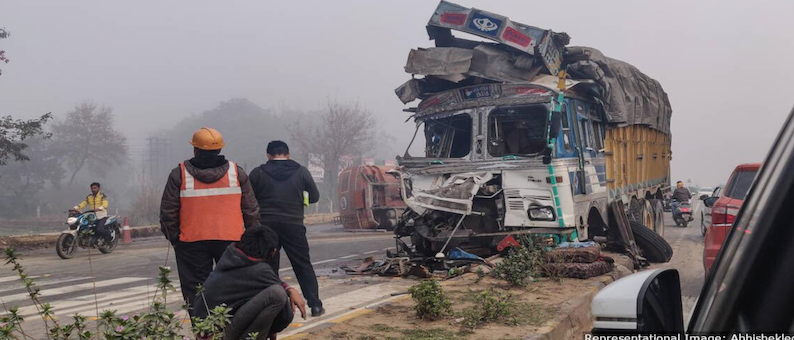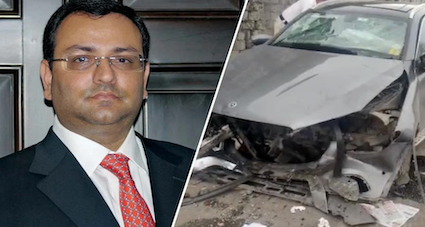By Sudip Choudhury
Cyrus Mistry’s death has brought the spotlight on 150,000 such annual fatalities on Indian roads described as the world’s deadliest.
One third of such deaths happen on national highways.
The accident also reignited the big Indian debate on road safety in the world’s fourth-largest car market with sales crossing three million. Car passengers accounted for 13 percent of road deaths in 2020. Airbags and seat belts, claim experts, would have saved at least one third of the 39,000 people who died in 2020.
India has exploded in pain and anger, the country’s road transport minister Nitin Gadkari has said he expects to finalise rules for all cars to have six airbags by the end of the current fiscal.
Gadkari did not say why car manufacturers took their products so lightly and did not push six airbags till date.
Car manufacturers, it is reliably learnt, were offered the draft rules at the start of this year but they shot down the proposals from the government, arguing it would inflate costs of the vehicles. As a result, the bags were not included in the vehicles, nor an alarm system for rear seat belts to enforce their use.
Serious differences have cropped up between the government and automobile manufacturers. The government says adding four more airbags would not cost more than $75, the car manufacturers say the costs would inflate by over $230.
It remains to be seen if car makers in India would try to be quality and safety conscious and not cost conscious. Maybe the changes will now happen, Mistry was a top corporate honcho, the former chairman of the Tata Sons.
Now, even national highways will come under government audit to make them safer, state ministers would be consulted to improve land discipline and push curbs on high speeds on highways. And inflate fines for non-compliance.
India’s political cognoscenti say there is no respect for the law and there is no fear of non-compliance.
Barring the pandemic year of 2020, which saw long periods of lockdowns, the data on accidents and deaths have been consistently hovering around 4.4 lakh and 1.5 lakh respectively through the period between 2017 and 2021.

The highest number of road accidents every year is attributed to negligent driving and speeding. Speeding caused 87,000 deaths, accounting for over half of all deaths, while dangerous and careless driving was attributed as the cause for 42,000 deaths in the latest NCRB report.
As in previous years, two-wheelers accounted for most deaths (44.5%), while buses accounted for 3% of deaths in accidents in 2021. The largest increase in the number of traffic accident cases from 2020 to 2021 was reported in Tamil Nadu (from 46,443 to 57,090), followed by Madhya Pradesh (from 43,360 to 49,493), Uttar Pradesh (from 30,593 to 36,509), Maharashtra (from 24,908 to 30,086), and Kerala (from 27,998 to 33,051).
Road Safety considerations have many contributory factors and, in this case, starting from Road Design (for a maximum speed) to Road Construction, to Road Signages and Lane Markings, to vehicle condition, to vehicle safety and eventually to the driver, expected to abide by the traffic rules.
The Burden of Road Safety
What is distressing is that the propaganda is shifting the burden of road safety to vehicle manufacturers under the garb of the number of airbags.
The road/highway may have been designed for 100+kms/hr but as the number of lanes reduce, in this case due to a bridge, the maximum speed is decreased substantially, and the reduction needs to be announced via signages long before the lanes merge and reduce in number such that the drivers can slow down and become alert.
In this particular case, the speed of the vehicle on approaching the bridge was around 130kms/hr. The vehicle was overtaking from the left – this is a sure no-no, especially when you are driving at such high speed and more so as one approaches a bridge.
So let’s analyse the accident once again.
The vehicle hit the road barrier on the left at about 80kms/hr, as the brakes were engaged as soon as the driver noticed the lane space being reduced. But that was dangerously late, ostensibly because the driver was overtaking at the same time.
The front passenger and driver were wearing seat belts and were injured. They also had airbags inflated instantly. Two passengers in the rear were not wearing their seat belts, they had no airbags.
The irony is that the authorities and media have placed their laser targets only on the number of airbags, whereas there have been multiple failures along the way.
Therefore, in a manner classical to India, the ones responsible for road safety very conveniently passed on the burden of accountability to the manufacturers on the point of count of airbags.
And then, there have been some shortfalls in the road design and inadequate signages. Putting up signages is a very scientific affair, hence even if they are there, they may prove ineffective if not placed in proper locations or illegible at certain speeds, or cluttered text etc.
Criticality of the road design is directly proportional to the volume of traffic and speed of traffic – higher
volume usually reduces the speed. But accidents can still happen if there is no enforcement of rules.
And finally, it is time to shift the focus to driver behaviour. Getting a licence by paying a bribe is common in India. It happens in both big and small cities. And then, in many instances, even a well-meaning, disciplined driver is forced to bend the
rules because others around aren’t following the rules.
Now comes the million-dollar question – who is to be held accountable or responsible for road mishaps, especially the fatal ones, if all the shortcomings are to be considered? In general, the ‘value of life’ is actually very low in our country and we lower it further by passing on the burden of upholding that value to others.
It is time to change. It is time to belt up.
(Sudip Choudhury is a seasoned architect who observes designs and its impact on society)


